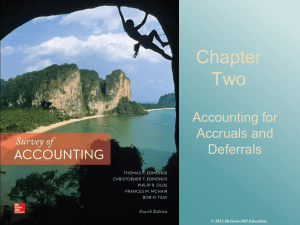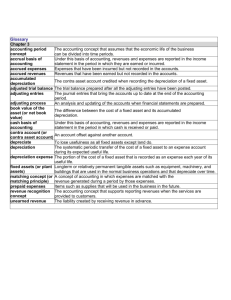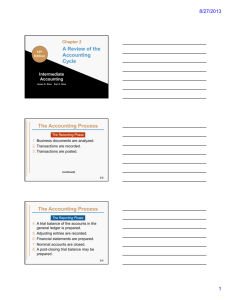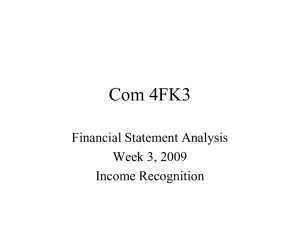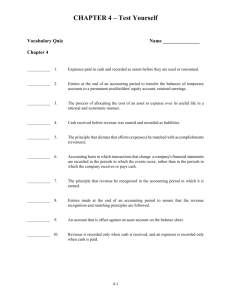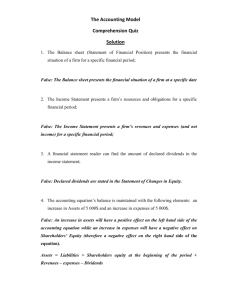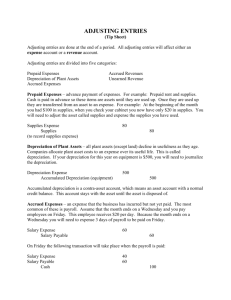1133957919_384261
advertisement
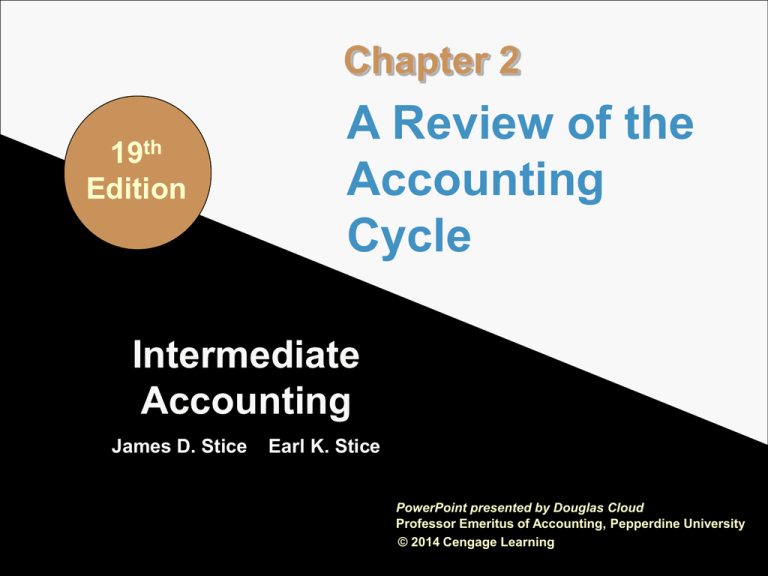
Chapter 2 19th Edition A Review of the Accounting Cycle Intermediate Accounting James D. Stice Earl K. Stice PowerPoint presented by Douglas Cloud Professor Emeritus of Accounting, Pepperdine University © 2014 Cengage Learning 2-1 The Accounting Process The Recording Phase 1. Business documents are analyzed. 2. Transactions are recorded. 3. Transactions are posted. (continued) 2-2 The Accounting Process The Reporting Phase 4. A trial balance of the accounts in the general ledger is prepared. 5. Adjusting entries are recorded. 6. Financial statements are prepared. 7. Nominal accounts are closed. 8. A post-closing trial balance may be prepared. 2-3 Accounting Terminology • Transactions are events that transfer or change goods or services between or among two or more entities. • Business documents, such as invoices, provide evidence that transactions have occurred as well as the data required to record the transactions in the accounting records. 2-4 Accounting Terminology • • Double-entry accounting is an old and universally accepted system for recording accounting data. Each transaction is recorded in a way that maintains the equality of the basic accounting equation: Assets = Liabilities + Owners’ Equity (continued) 2-5 Accounting Terminology • A debit is an entry on the left side of an • • • account. A credit is an entry on the right side of an account. Assets, expenses, and dividends are increased by debits and decreased by credits. Liabilities, capital stock, retained earnings, and revenues are increased by credits and decreased by debits. 2-6 Three-Step Journal Entry Process 1. Identify the accounts involved with an event or transaction. 2. Determine whether each account increased or decreased (this information, coupled with the answer to step 1, will tell you if the account was debited or credited). 3. Determine the amount by which each account was affected. 2-7 Analyzing Business Documents • • • Normally, a business document, or source document, is the first record of each transaction. The business document provides support for the data to be recorded in the journals. Documents underlying each recorded transaction provide a means of verifying the accounting records and thus form a vital part of the information and control systems. 2-8 Journalizing Transactions • • • Once the information provided on business documents has been analyzed, transactions are recorded in chronological order in the appropriate journal or journals. A special journal is used to record a particular type of frequently recurring transaction. The general journal is used to record all transactions for which a special journal is not maintained. 2-9 Posting to the Ledger Accounts • An account is used to summarize the • • effects of transactions on each element of the expanded accounting equation. A ledger is a collection of accounts maintained by a business. The transfer of information from the journal to the appropriate accounts in the ledger is referred to as posting. 2-10 Establishing Separate Ledgers • • The general ledger includes all accounts appearing on the financial statements, and separate subsidiary ledgers afford additional detail in support of certain general ledger accounts. The general ledger account that summarizes the detailed information in a subsidiary ledger is known as a control account. 2-11 Preparing a Trial Balance • After all transactions for the period have • • been posted to the ledger accounts, the balance for each account is determined. A trial balance is a list of all accounts and their balances. It provides a means to assure that total debits equal total credits. 2-12 Preparing Adjusting Entries • Although the majority of accounts are up to date • at the end of the accounting period and their balances can be included in the financial statements, some accounts require adjustment to reflect current circumstances. At the end of each accounting period, in order to report all asset, liability, and owners’ equity amounts properly and to recognize all revenues and expenses for the period on an accrual basis, accountants are required to make adjusting entries prior to preparing financial statements. 2-13 Steps to Analyze Circumstances 1. Determine whether the amounts recorded for all asset and liabilities is correct. 2. Determine what revenue or expense adjustments are required as a result of the changes in recorded amounts of assets and liabilities indicated in step 1. 2-14 Areas Most Commonly Requiring Analysis Transactions where cash will be exchanged in a future period: 1. Unrecorded assets—Assets and revenues that have been earned but not yet recorded. 2. Unrecorded liabilities—Expenses and liabilities that have been incurred but not yet recorded. (continued) 2-15 Areas Most Commonly Requiring Analysis 3. Prepaid expenses—Expenses that have been recorded but not yet incurred. 4. Unearned revenues—Revenues that have been recorded but not yet earned. 2-16 Unrecorded Assets • Revenues should be recorded when earned, regardless of when cash is received. • This ensure that all receivables are properly reported on the balance sheet in the correct amounts. • The unrecorded receivables are earned and represent amounts that are receivable in the future. (continued) 2-17 Unrecorded Assets (a) If revenue is earned but not yet collected in cash, a receivable exists. Rosi, Inc., has interest on a note receivable of $250. Interest Receivable Interest Revenue To record accrued interest on notes receivable. 250 250 2-18 Unrecorded Liabilities • Liabilities can be created by expenses being incurred prior to being paid or recorded. • Adjusting entries are required at the end of the accounting period to recognize any unrecorded liabilities. (continued) 2-19 Unrecorded Liabilities (b) Rosi, Inc., had unrecorded salaries and wages amounting to $2,150 at the end of the accounting period. Salaries and Wages Expense Salaries and Wages Payable To record accrued salaries and wages. 2,150 2,150 (continued) 2-20 Unrecorded Liabilities (c) Rosi, Inc., firm accrued interest of $5,000 on a bond payable. Interest Expense Interest Payable To record accrued interest on bonds. 5,000 5,000 (continued) 2-21 Unrecorded Liabilities (d) Rosi, Inc., owed federal and state income taxes totaling $8,000. Income Tax Expense Income Taxes Payable To record income taxes. 8,000 8,000 2-22 Prepaid Expenses • Payments that a company makes in advance for items normally charged to expense are known as prepaid expenses. • • An expense is the using up of an asset. The adjusting entry shows the complete consumption of an asset. 2-23 Prepaid Expenses Originally Debited to an Asset Account If the asset account was originally debited, the adjusting entry requires that an expense account be debited for the amount applicable to the current period and the asset account credited. (continued) 2-24 Prepaid Expenses Originally Debited to an Asset Account (e) The expired portion of Rosi Inc.’s prepaid insurance is $4,200. The following adjusting entry is required: Insurance Expense Prepaid Insurance To record expired insurance ($8,000 – $3,800 = $4,200). 4,200 4,200 (continued) 2-25 Prepaid Expenses Originally Debited to an Asset Account If an expense account was originally debited, the adjusting entry requires that an asset account be debited for the amount applicable to future periods and the expense account be credited. (continued) 2-26 Prepaid Expenses Originally Debited to an Asset Account If Rosi’ Inc., had originally debited Insurance Expense for $8,000, the expense account shows $8,000, but $3,800 is applicable to future periods. The adjusting entry would be as follows: Prepaid Insurance Insurance Expense To record prepaid insurance ($8,000 – $4,200 = $3,800). 3,800 3,800 2-27 Unearned Revenues • Amounts received before the actual earning of revenues are known as unearned revenues. • Because the company has received cash but not yet given the customer the purchased goods or services, the unearned revenues are in fact liabilities. 2-28 Unearned Revenues Originally Credited to a Revenue Account (f) As indicated in the trial balance for Rosi, Inc., rent receipts are recorded originally in the rent revenue account. Unearned revenue at the end of 2013 is $475, and is recorded as follows: Rent Revenue Unearned Rent Revenue To record unearned rent revenue. 475 475 2-29 Unearned Revenues Originally Credited to a Liability Account If a liability account was originally credited, this account is debited and a revenue account is credited for the amount applicable to the current period. Unearned Rent Revenue Rent Revenue To record rent revenue ($2,550 – $475). 2,075 2,075 (continued) 2-30 Unearned Revenues Originally Credited to a Liability Account The following T-accounts illustrate the effect that this adjusting entry would have on the relevant accounts: 2-31 Transactions Involving Estimates Asset Depreciation • Operations are charged with a portion of the asset’s cost, and the carrying value of the asset is reduced by that amount. • A reduction in an asset for depreciation is usually recorded by a credit to a contra account, which is set up to record subtractions from related accounts. (continued) 2-32 Transactions Involving Estimates Asset Depreciation (g) Rosi Inc., estimated depreciation at the end of the year to be five percent for buildings and ten percent for furniture and equipment. Depreciation Expense—Building Accumulated Depreciation— Building To record depreciation on buildings at 5% per year. (continued) 7,800 7,800 2-33 Transactions Involving Estimates Asset Depreciation (g) Depreciation Expense—Furniture & Fixtures Accumulated Depreciation— Furniture & Fixtures To record depreciation on furniture and equipment at 10% per year. 1,900 1,900 2-34 Bad Debts • Invariably, when a business allows customers to purchase goods and services on credit, some of the accounts receivable will not be collected. • Under the accrual concept, an adjustment should be made for estimated expense in the current period rather than when specific accounts become uncollectible. (continued) 2-35 Bad Debts (i) Rosi Inc.’s estimated Allowance for Bad Debts is to be increased by $1,100. Bad Debt Expense Allowance for Bad Debts To adjust for estimated bad debt expense. 1,100 1,100 2-36 Adjusting Entry Summary • Adjusting entries do not involve cash. • Adjusting entries always involve a balance sheet account and an income statement account. 2-37 Preparing Financial Statements 1. Identify all revenues and expenses—these account balances are used to prepare the income statement. 2. Compute the net income—subtract expenses from revenues. 3. Compute the ending Retained Earnings balance. 4. Prepare a balance sheet using the balance sheet accounts from the trial balance and the modified retained earnings balance. 2-38 Using a Spreadsheet • • Nominal (or temporary) accounts: Closed to a zero balance at the end of each accounting period. All income statement accounts and the dividend account are closed. Real (or permanent) accounts: Not closed to a zero balance at the end of the accounting period. Carried forward to the next period. 2-39 The Closing Process Revenues xx Retained Earnings Beg. Bal. xxx Revenues Bal. xxx Since the revenue account is a nominal account, it is closed at the end of the period to Retained Earnings. (continued) 2-40 The Closing Process Retained Earnings Expenses Expenses Bal. xxx xx Beg. Bal. xxx Revenues Each expense account is credited in order to close the account at the end of the period. (continued) 2-41 The Closing Process Retained Earnings The dividends account, which is also nominal, is credited to close out the balance. Expenses Dividends Beg. Bal. xxx Revenues Dividends Bal. xxx (continued) x x 2-42 The Closing Process Retained Earnings Retained Earnings is a real account and always carries a balance. Net Income for the period is determined by these two items. Expenses Dividends Beg. Bal. xxx Revenues Dividends reduce Retained Earnings. 2-43 Post-Closing Trial Balance • • Provides a listing of all real account balances at the end of the closing process. The post-closing trial balance is prepared to verify the equality of debits and credits for all real accounts. 2-44 Accrual Accounting • • • Accrual accounting recognizes revenues as they are earned, not necessarily when cash is received. Expenses are recognized as they are incurred, not necessarily when cash is paid. Provides a better basis for financial reporting, according to the FASB. 2-45 Cash-Basis Accounting • Cash-basis accounting is focused on cash receipts and cash disbursements. • Typically used by service businesses, such as CPAs, dentists, and engineers. • AICPA holds that it is appropriate for small service companies. 2-46 Computers and Accounting • • • Many steps of the accounting cycle are performed using computers. Typical computerized functions include generating reports and computational analysis. The computer will never replace a good accountant! (continued) 2-47 Computers and Accounting A recent development in the use of computers in financial reporting is the spread of XBRI: • Stands for eXtensible Business Reporting Language. • Is a method of embedding computer-readable tags in financial report documents. • Allows a company to download its financial statements into spreadsheets where they can be compared to the financial statements of other companies that have also been downloaded. 2-48 Chapter 2 ₵ The End $ 2-49 2-50
